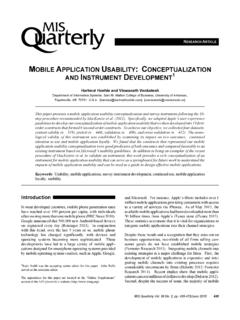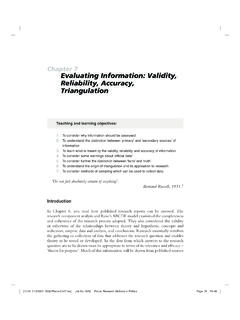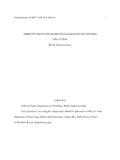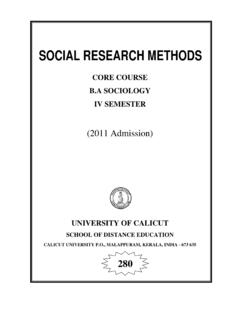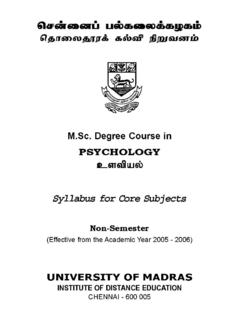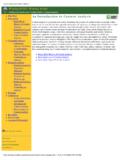Transcription of BRIDGING THE QUALITATIVE–QUANTITATIVE …
1 research ESSAYBRIDGING THE qualitative quantitative DIVIDE:GUIDELINES FOR CONDUCTING MIXED METHODSRESEARCH IN INFORMATION SYSTEMS1 Viswanath VenkateshDepartment of Information Systems, Walton College of Business, University of Arkansas,Fayetteville, AR 72701 A. BrownManagement Information Systems Department, Eller College of Management, University of Arizona,Tucson, AZ 85721 BalaOperations and Decision Technologies, Kelley School of Business, Indiana University,Bloomington, IN 47405 methods research is an approach that combines quantitative and qualitative research methods in thesame research inquiry.
2 Such work can help develop rich insights into various phenomena of interest thatcannot be fully understood using only a quantitative or a qualitative method. Notwithstanding the benefits andrepeated calls for such work, there is a dearth of mixed methods research in information systems. Building onthe literature on recent methodological advances in mixed methods research , we develop a set of guidelinesfor conducting mixed methods research in IS. We particularly elaborate on three important aspects ofconducting mixed methods research : (1) appropriateness of a mixed methods approach; (2) development ofmeta-inferences ( , substantive theory) from mixed methods research ; and (3) assessment of the quality ofmeta-inferences ( , validation of mixed methods research ).
3 The applicability of these guidelines is illustratedusing two published IS papers that used mixed : Meta-influences, mixed methods, multimethod, positivist, qualitative , quantitative , researchmethod, research design, validityIntroduction1 Diversity in research methods is considered a major strengthof information systems (IS) research (Lee 1999; Robey 1996;Sidorova et al. 2008). IS researchers have employed aplethora of different research methods that can, at one level,be broadly categorized into two: quantitative and qualitative (Lee and Hubona 2009; Myers and Avison 2002).
4 One of therecurring issues in social and behavioral sciences research isthe relative value of different research approaches, especiallywith intense debates on different epistemologies ( ,positivist versus interpretive) and methodologies ( , quali-tative versus quantitative ). Although there have been in-creasing calls for going beyond the rhetoric of the differencesamong epistemologies and methodologies to develop adisciplined methodological pluralism (Landry and Banville1 Debbie Compeau was the accepting senior editor for this paper.)
5 MichaelBarrett served as the associate Quarterly Vol. X No. X, pp. 1-XX/Forthcoming 2012 2013 1 Venkatesh et the qualitative quantitative Divide1992; Weber 2004), there is limited research that has em-ployed methodological pluralism in the IS literature (Kaplanand Duchon 1988; Mingers 2001, 2003). In particular,although the current state of methodological diversity in ISresearch is encouraging, there is a dearth of research in IS thatemploys a mixed methods2 approach ( , use of bothqualitative and quantitative methods in a single researchinquiry)3 that builds on a common scientific basis essential toadvance and sustain the tradition of methodological diversityin IS research and to create a cumulative body of knowledge(Lee and Hubona 2009; Mingers 2001, 2003; Weber 2004).
6 Mixed methods research has been termed the third method-ological movement (paradigm), with quantitative and quali-tative methods representing the first and second movements(paradigms) respectively (Ridenour and Newman 2008;Teddlie and Tashakkori 2003, 2009). Although proponents ofmixed methods research have suggested areas in which amixed methods approach is potentially superior to a singlemethod design, there has been intense debate regardingwhether or not it is even appropriate to combine multiplemethods that are often based on radically different paradig-matic assumptions (Denzin and Lincoln 1994; Guba 1987).
7 Despite the several challenges associated with methodologicalpluralism based on the notion of the incompatibility thesis,4 ithas been suggested that it is, in fact, feasible to conductresearch that cuts across multiple methodologies and par-adigms (Mingers 1997, 2001; Ridenour and Newman 2008;Teddlie and Tashakkori 2003, 2009). Several researchershave reviewed prior calls for methodological combination andsuggested that a peaceful coexistence of multiple method-ologies is possible (Datta 1994; House 1994; Ridenour andNewman 2008; Rossi 1994).
8 Others have called for a com-bination of research methods, particularly triangulation ofqualitative and quantitative data, to develop a deeper under-standing of a phenomenon (Denzin 1978; Jick 1979; Mingers1997, 2001; Reichardt and Rallis 1994).Despite such calls for methodological pluralism and thebenefits of combining multiple methods, there has not beenmuch research in IS that has employed a mixed methodsapproach. Our review of the IS literature suggests that lessthan 5 percent of the empirical studies published between2001 and 2007 in the six major IS journals identified in theSenior Scholars Basket of Journals (AIS 2007)5 haveemployed mixed methods.
9 Considering the strength of mixedmethods research with respect to understanding and ex-plaining complex organizational and social phenomena, thereis clearly a need for IS researchers to conduct and publishresearch that employs mixed methods (Cao et al. 2006;Mingers 2001). However, we observe that although guide-lines for conducting and evaluating different types of research ( , quantitative , positivist case study, interpretive casestudy, design science, and action research ) have been widelyavailable in the IS literature ( , Dub and Par 2003;Hevner et al.)
10 2004; Klein and Myers 1999; Lee 1989;Mingers 2001; Myers and Klein 2011; Straub et al. 2004),guidelines for conducting and evaluating mixed methodsresearch in IS are lacking. Further, mixed methods researchhas received much attention in the social and behavioralsciences recently (for a review, see Tashakkori and Creswell2008), and we suggest that IS research can benefit from thisresearch approach, especially with a broadening base ofinterdisciplinary research and calls for more of the same (seeVenkatesh 2006).Our view is consistent with researchers who suggest that apeaceful coexistence of multiple paradigms is feasible in aresearch inquiry.


